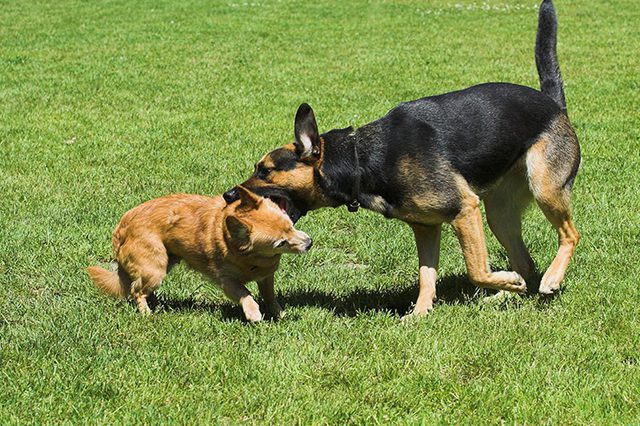Leash reactivity (lunging/barking/growling on leash at other dogs, people, or small animals) can develop from a multitude of reasons, and it is actually the number one problem dog owners contact me about for training! It usually starts with a small growl, a look, or tension and before you can blink it turns into a full blown meltdown at the end of the leash. So let's break it down:
1. Why it Happens
It can happen for one of two reasons. The dog is scared and throwing a fit makes the other dog/person back away/give space, or the dog is extremely excited and the leash (or fence) creates frustration that the dog can't reach what they want so a meltdown ensues. A lot of dogs are fine once off-leash because they can either create space or are able to reach what they want. This is exactly why I don't immediately categorize these dogs as aggressive, even if the behavior looks scary.
- Fear: Fearful dogs want to run away. If they can't escape they will do the next best thing, which is fight (or at least let everyone know they are ready to). Many times we miss the opportunity to advocate for our dogs at the first sign of them being uncomfortable. This develops into a pattern and they learn that if they go on the offense and act intimidating, no one will even approach them.
- Excitement: Excited dogs often times lack impulse control, so as soon as they see another dog, they want to go and greet it! Obviously the leash will prevent that and the frustration of not being able to greet can cause an explosion of sorts. This can also develop into a habit of seeing dog = meltdown.
How to Fix it:
I always tell my clients that dog training is a lifestyle, not a set of commands. The reasons for dogs bad behavior has many layers and breaking them down makes them easier for you and your dog to digest.
1. Build Impulse Control Inside
A dog's attitude has everything to do with bad behavior so we always start there. If your dog feels entitled to run the show inside the house, they will most certainly feel that way on the walk. Leadership exercises are where we start: Going through thresholds, coming in and out of the crate and waiting for food. These exercises are such a valuable way to build impulse control and teach your dog that they need to wait patiently and not act on every single feeling they have. Leash reactivity starts long before the walk with your dog even begins.
2. Block the reaction
When dogs are excited or fearful, their emotions are in a heightened state. Their adrenaline is pumping and hearts racing so making good decisions is much harder, if not impossible for them to do. When we block this response, it allows them to clear their mind and focus in on what is important, you! The interruption can be with an Ecollar tap, prong collar correction, pet corrector, or whatever is valuable enough to your dog to stop. If we do not use a consequence that the dog deems valuable, we allow them to stay stuck in an endless loop of anxiety and frustration.
3. Show the dog behavior that you do want
Once your dog has a clear mind, we can start showing them what we do want. Dogs want to know that someone is in charge, so they don't have to worry or stress our about what is going to happen next. We ask all of our dogs for a nice heel, so that becomes their "job" and the only thing they need to focus on during their walk. This allows dogs to relax and just enjoy their time outside with you. For reshaping your dogs emotional response to other dogs we use a "crittering" technique you can learn more about here. In short, we teach dogs using Ecollar pressure on low-levels that being overly aroused by other dogs or small animals isn't as comfortable anymore, and when they make the choice to redirect their attention they are rewarded with food.
This is of course a condensed break-down of leash reactivity, and there are many variables that I haven't touched on. It is a process, but please know that there is hope! Dog's bad behavior are habits, built over time. The great part about this is that new habits can be built in their place!






